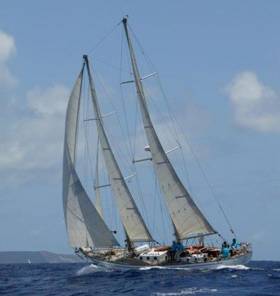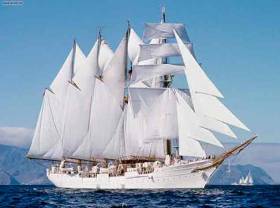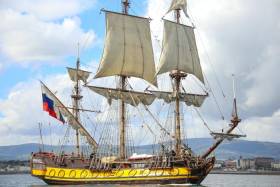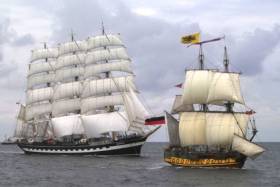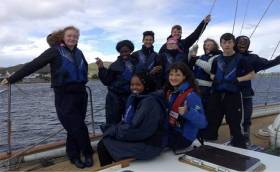Displaying items by tag: Tall Ships
The Spirit of Asgard – A Reunion Voyage for Former Tall Ship Asgard II Trainees & Crew
Sail Training Ireland announced their Spirit of Asgard Reunion Voyage to be held from 12th – 18th of May 2018. The voyage will celebrate the spirit of the Asgard II Sail Training Tall Ship. Twenty eight former Asgardians will come together for a six-day voyage around the Irish sea on board the Tall Ship Pelican. In conjunction with the voyage, a gala ball will be held for former trainees, families, and friends.
The Spirit of Asgard voyage and ball will take place ten years after the tragic sinking of the much-loved Tall Ship Asgard II. The event will bring the former Asgard II trainees together to relive their amazing experience by taking part in a tall ship voyage and to share their stories and experiences. This voyage will serve to highlight to young people today that the same opportunities are available today via Sail Training Ireland’s annual programme of voyages.
“Born in Limerick with very little opportunity to sail on the sea, I took my first voyage on Asgard II at the age of 23 years. I sailed on Asgard II every year to 2008 starting as a trainee and progressing to watch leader. This life changing experience opened my eyes to a whole new world and great memories. Now faced with a new challenge as an amputee, Sail Training Ireland have given me the opportunity to fulfil my ambition get on board again” said Frank Hogan.
Sail Training Ireland has continued the work of Asgard since her tragic sinking and has placed over 1600 “Asgardians” since 2011. The charity promotes youth development and education to people from all backgrounds and abilities on the island of Ireland by providing access to sail training voyages. In this challenging and fun environment, the trainees learn about themselves, leadership, responsibility, resilience, team work, overcoming adversity, friendship, and cooperation. As a bonus almost, they learn about sailing and the sea.
“We believe this experience builds resilience and an inner confidence in those that take part. In some cases it can be life changing. We are looking forward to hearing the stories of past Asgardians and how the experience changed their lives” according to Daragh Sheridan, CEO of Sail Training Ireland.
Anybody interested in taking part in the Spirit of Asgard Voyages or attending the gala ball should call 01 816 8866. For other voyage opportunities see the full voyage calendar on the site. No experience is necessary.
#tallships- Last year a visit to Scotland was made to investigate a former Irish Lights lightship dating to 1910 that in much more recent years had been a museumship there but is now to be found relocated in England to finally begin restoration work, writes Jehan Ashmore.
Launched as the lightship, Penguin for the Commissioners of Irish Lights at the Dublin Drydock Company, the vessel now named Arctic Penguin of Glasgow is now a rare surviving example of an Irish built vessel. Constructed of an iron hull on a steel frame. Above decks a fixed lantern was fitted to warn off shipping from the dangers along our coasts. Between 1910 and 1920 the Penguin was located at the Daunt Rock Station. After that decade the vessel served as a spare lightship.
In 1966 the lightship was sold and throughout the last half century has served several subsequent owners. Notably, in 1982 a conversion took place that saw an engine installed on the vessel that became a three-masted schooner offering sail training excursions.
The attractive town of Inveraray on Loch Fyne has been home to this floating landmark for many years. Since 2010, however the ship's role there as a maritime museum ceased. In addition access to the deterioting pier has been closed to locals and tourists alike by Argyl and Bute Council.
Arctic Penguin was towed away this year from the stunning scenery of the Scottish loch to the Cumbrian port of Barrow-in-Furness. Since arrival initial repairs have taken place to the 100ft vessel that is to be drydocked on the Wirral, from where the ship will be restored to seagoing condition.
Instead of operating from the Scottish west coast as previously reported, Arctic Penguin will be based out of Barrow. Earlier this year the north-west English port marked its 150th anniversary with celebrations that included vessels among them Arctic Penguin (see pictured) calling closer to the town quays.
At 107 years old, Arctic Penguin is rightly recognised as a vessel of importance, as the former lighship is listed on the National Register of Historic Vessels (NRHV) which comprises of more than 1,300 vessels. This register is one of several organised by the National Historic Ships UK, the official voice for historic vessels in the UK.
Syrian Refugees & Ballaghaderreen Youths Form Bonds at Sea
Five Irish young people from Ballaghaderreen, Co. Roscommon and five Syrian refugee young people also living in Ballaghaderreen, nominated by UNHCR Ireland, are currently taking part on a life-changing sailing voyage on board of the Spirit of Oysterhaven, Ireland’s largest sail training vessel. The five Syrian refugees were brought to Ireland as part of the Irish Refugee Resettled Programme.
The 10 sail trainees departed from Cork on Sunday, and will be reaching Glandore, their final destination, at lunchtime on Friday, 21st July. The voyage brings the young people together both as ship-mates and friends.
During the 5 days of the voyage, the participants have been learning how to sail a ship and how to navigate in challenging Irish coastal waters, making their own decisions about what course to plot over the week. In the process they learn the vital importance of working as a team 24-hours a day while assuming individual responsibilities, as they take the helm, set sails, stand watches, cook for each other and keep the vessel ship-shape.
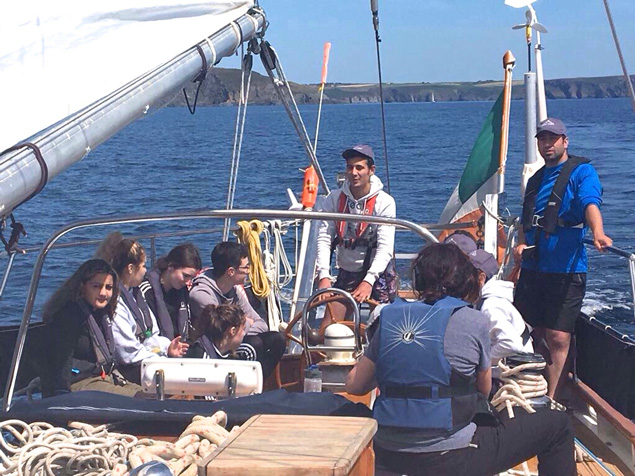 The Ballaghaderreen crew aboard Sprit of Oysterhaven in the gentle weather earlier this week. They’ll have experienced more rugged conditions by the time they reach Glandore tomorrow (Friday).
The Ballaghaderreen crew aboard Sprit of Oysterhaven in the gentle weather earlier this week. They’ll have experienced more rugged conditions by the time they reach Glandore tomorrow (Friday).
Overcoming the challenges of life at sea also enables the young people to believe in their own potential, while developing relationships amongst their own peers in the new community in which they live. Sail Training induces then the development of respect, understanding and work ethic, bringing tangible benefits to communities in Ireland.
Shauna Gillan, founder of Safe Haven Ireland, says
“Integration is so important in modern Ireland - sail training is an ideal way to foster bonds between communities. Participants on board this week are from one local area – Ballaghaderreen. The young people on this voyage therefore made new friends from their own new community. The integration benefits will ripple through Ballaghaderreen once they return to dry land through their relationships with each other, their parents and wider social networks.”
The Spanish Embassy in Dublin and Dublin Port Company have announced that one of the world’s oldest and largest tall ships, the “Juan Sebastián de Elcano” will make a five-day visit to Dublin Port, arriving on Saturday, 10th June and departing on Thursday, 15th June. The 370-foot long, four-masted schooner is the world’s third largest tall ship and one of the oldest tall ships still sailing.
The majestic steel-hulled schooner led by Captain Victoriano Gilabert will arrive in Dublin Port at 9am on Saturday carrying 245 crew on board. The ship is used as a training vessel for the Royal Spanish Navy, preparing its Officers for long periods at sea. King Felipe VI is among the Officers who have been trained on board the ship, which is named after Spanish explorer Juan Sebastián de Elcano, captain of Ferdinand Magellan's last exploratory fleet, and the first man to circumnavigate the globe.
While in Dublin, the crew will participate in a range of engagements to promote Spanish-Irish cultural exchange, including an open day for the public.
The ship will initially berth at Ocean Pier (no public access) in Dublin Port, before moving to Berth 18 beside the Tom Clarke Bridge, where she will be open to the public to visit free of charge on Wednesday, 14th June. Visitors are welcome to come and see first-hand the craftsmanship and young crew at work on board this stunning vessel.
Public Opening
Date: Wednesday, 14th June
Time: 10.00 to 13.00 and 15.30 to 19.00
Location: Berth 18 (beside Tom Clarke Bridge)
The ship, now on its 89th training voyage, departed from Cádiz (Spain) on March 12th and sailed to Santo Domingo (Dominican Republic) and New York. The ship then set sail across the Atlantic back to Spain and from the Port of Marín is now en route to Dublin Port. Built in Cádiz (Spain) and launched in 1927, the “Elcano” has visited over 197 ports in more than 70 countries, and of its 89 cruises to date, 10 have been round-the-world trips. Since its first voyage she has clocked up more than 1.8 million nautical miles.
The last time the “Elcano” visited Dublin Port was in June 2014. Her next ports of call include Den Helder (The Netherlands) and Antwerp (Belgium) before returning to Spain.
Eamonn O’Reilly, Chief Executive of Dublin Port Company, said: “Dublin Port Company welcomes the return of the Juan Sebastián de Elcano and her crew to Dublin Port. Dublin Port has a longstanding tradition of hosting visiting navy and sharing in the history and culture of other seafaring nations. The Elcano is one of the finest tall ships in the world, and her arrival is sure to capture the interest and imagination of people here, providing a unique opportunity to learn more about Spain’s naval heritage.”
His Excellency, José María Rodríguez Coso, Ambassador of Spain to Ireland, said: “The arrival to Dublin of the Elcano is an event of major importance and significance. The ship is a floating embassy, and the fact that Dublin has been chosen as a port of call symbolises the strength of the bilateral relations between Ireland and Spain.”
Tall Ships sailed under gentle south-west winds up the River Liffey and into Dublin Port at lunchtime having spent the night at anchor on the South side of Dublin Bay off Sandycove.
The Tall Ships are in port and open to the public for free (tide permitting on the River Liffey) between noon and 6pm on each of the three days as part of Riverfest.
Included in those visiting is the legendary Russian vessel Shtandard, a replica of a warship of Peter the Great from 1703. The Shtandard was the third vessel in a parade of sail across Dublin bay this morning asten of the Pelican and the Earl of Pembroke but ahead of The Kaskelot.
 Pelican leads the Tall ships across Dublin Bay. Photo: Afloat.ie
Pelican leads the Tall ships across Dublin Bay. Photo: Afloat.ie
Read also:
Eight Tall Ships Open to the Public As Dublin Port Riverfest Set to Attract Over 100,000 Visitors
Tall Ships Arrive in Dublin Bay, Earl Of Pembroke & Kaskelot Sail in For Riverfest
Dublin Port Riverfest Tall Ships to be Nautical Highlight of Crowded Bank Holiday Weekend
Dublin Port Riverfest Tall Ships to be Nautical Highlight of Crowded Bank Holiday Weekend
For anyone interested in boats and the sea, the June Bank Holiday Weekend is always busy with multiple maritime happenings, many of which will be of interest to all the family writes W M Nixon. But if sailing is specifically your thing, the variety of options available is almost bewildering. Owing to some trick of this year’s calendar, events which would normally be held a week hence are being pushed into this already crammed holiday schedule, yet it will somehow all be managed in the end.
However, if you want to focus on just one event which best gets the spirit of it all, the Dublin Port Riverfest from Saturday 3rd to Monday 5th June on our beloved River Liffey and its many quaysides promises to have something for everyone. There’ll be Tall Ships in port after arriving today, and while their numbers won’t match the huge fleets which follow the official Sail Training International programme, there’ll be more than enough to interest genuine enthusiasts, with all the vessels open to the public for free (tide permitting) between noon and 6.0pm on each of the three days.
Included in those visiting is the legendary Russian vessel Shtandard, a replica of a warship of Peter the Great from 1703. While her size in no way matches that of the Russian 4,000 ton square rigger Kruzenshtern, those who are thinking in terms of an Irish sail traning ship in the fullness of time will note that the manageably-sized Shtandart – which is coming to Ireland fresh from a starring role at the Festival of Sail in the Morbihan in France – is in superb order, a real ambassador for Russia, whereas the giant Kruzenshtern is becoming unmanageably large to keep in proper commission.
 The clean-lined square rigger Kaskelot will be in Dublin for the holiday weekend
The clean-lined square rigger Kaskelot will be in Dublin for the holiday weekend
Other noted square-riggers in port, as Afloat.ie reported earlier, will include Kaskelot, the Earl of Pembroke, and the Pelican. But past experience has shown that the modern pubic seeks much more variety than just an endless round of queuing to get aboard a tall ship. So the river itself is going to be used for a continuous show of powerboats racing and a colourful variety of waterborne stunts and competitions in order to keep the expected crowd of 100,000 over the three days well entertained.
However, if it’s sailing you seek in the midst of all this, Poolbeg Yacht & Boat Club’s marina at Ringsend is the focal point for a three day regatta which will include Old Gaffers racing, while on Saturday evening down at the end of the South Bull Wall, boats competing in the Irish Sea Offshore Racing Association’s version of the Lambay Race will be finishing their race at a line specially provided by Poolbeg Y&BC.
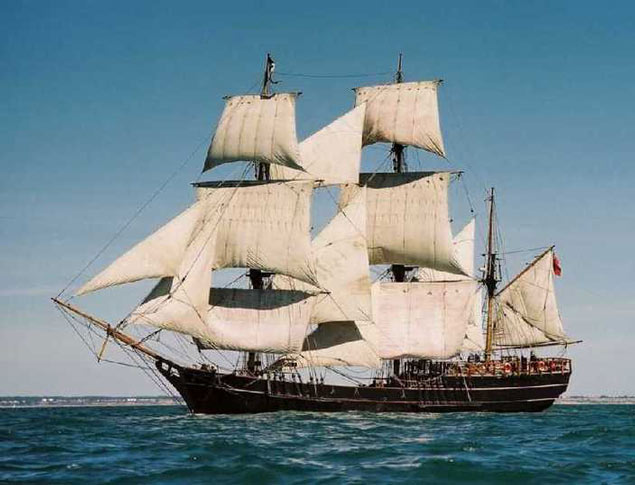 The Earl of Pembroke sets a brigantine rig.
The Earl of Pembroke sets a brigantine rig.
Just a day late for Dun Laoghaire harbour's 200th commemorations and 24 hours early for Dublin Port's Riverfest there is no doubting the evocative age of sail with the arrival of two tall ships sailing into Dublin Bay this morning.
The Earl Of Pembroke is moored in Scotsman's Bay, on the southside of Dublin Bay. The authentic square rigger is a replica of HMS Endeavour, the ship in whcih Captain Cook travelled to Australia in 1768. The modern Earl of Pembroke is 'for hire' for filming, charity and corporate events, as well as for personal charters and holidays. Read more on the Earl Of Pembroke here. The Earl of Pembroke is expected to sail from Dun Laoghaire up the River Liffey tomorrow at noon.
Read our Tall Ships Riverfest preview here
 Kaskelot, one of the last classic wooden Tall Ships, arrives in Dun Laoghaire Harbour
Kaskelot, one of the last classic wooden Tall Ships, arrives in Dun Laoghaire Harbour
The Kaskelot, a three-masted barque, is one of the largest remaining wooden ships in commission. She is moored in Dun Laoghaire Harbour today in advance of the weekend's Dublin Port's Riverfest that is previewed here. Read more on the Kaskelot here.
Although Riverfest is advertising eight tall ship arivals, there are only four visiting Dublin which could in any way be called a Tall Ship. After the arrival of the two this morning, it’s all eyes on the horizon for the Shtandard, the great Russian Tall Ship that will also visit Drogheda Port's Maritime Festival later this month.
Eight Tall Ships Open to the Public As Dublin Port Riverfest Set to Attract Over 100,000 Visitors
Dublin Port is preparing to help some 100,000 visitors discover their sea legs this June bank holiday weekend at Riverfest 2017, Ireland’s premier sailing and maritime festival. Now in its fifth year, the three-day maritime event will provide an €1 million boost to the local economy.
Taking place between the Samuel Beckett Bridge and the 3Arena from June 3rd -5th, Riverfest offers entertainment and activities for all the family, and admission is free.
Each year Riverfest, which is held by Dublin Port Company in association with Dublin City Council, brings a carnival atmosphere to North Wall Quay.
On the water, there will be plenty of thrills such as the UK ThunderCats power boats, which will be headlining the event with their first ever Dublin performance. ThunderCat Racing is one of the world’s most exhilarating water sports, with boats flying up to six metres in the air. The ThunderCats will be racing four times daily over the weekend.
Jet pack demonstrations and water sports such as stand up paddle boarding, sailing and kayaking are also among the highlights on the water.
For those who want to keep their feet on dry land there will be music, food markets, a funfair, zip lines, rock climbing and so much more. A new addition to Riverfest this year is the Drive-in cinema, which will use the world’s biggest mobile LED screen to show retro classics, Finding Nemo, Back to the Future and Jaws. Booking is essential.
Tall Ships Arrive
The festival’s favourite arrive in the city on Friday 2nd June. That afternoon the ships will berth along North Wall Quay and remain for the duration of the festival. Eight Tall Ships will be open to the public over the weekend to visit free of charge.
Eamonn O’Reilly, Chief Executive of Dublin Port Company, said: “I’m delighted to see Riverfest in its fifth year and growing from strength to strength. The festival promises something for absolutely everyone to enjoy. Set against the backdrop of the River Liffey, the Samuel Beckett Bridge and North Wall Quay, Riverfest is a uniquely Dublin experience. The sight of tall ships and schooners on the quayside reminds us of Dublin’s rich maritime heritage and modern day status as a port city. I would encourage everyone to come along and enjoy the spectacle and fun of Riverfest this year.”
Dublin City Council Chief Executive, Owen Keegan, said: “Riverfest is evolving as one of the marquee events of the city. The animation on and along the river over the bank holiday weekend is an exciting spectacle and festival for Dubliners and it further promotes Dublin to visitors as a city of culture and heritage.”
International Sail Training Award For Spirit of Oysterhaven Tall Ship & Safe Haven
Cork based Tall Ship Spirit of Oysterhaven sail training vessel & Safe Haven Ireland, a sail training charity that focuses on the integration of migrants in Irish society, and has won an international award at the International Sail Training Awards.
These awards are presented to vessels, vessel operators, individuals and organisations that have made a significant contribution to sail training. The winners are decided by an STI awards committee and were announced at the International Sail Training and Tall Ships Conference.
The ceremony took place in Sweden in November 2016 and the award will be presented to Safe Haven Ireland at the Mansion House, courtesy of Lord Mayor of Dublin Brendan Carr, in Dublin on 28 January 2017, at the 5th Annual Irish Sail Training Awards.
Safe Haven Ireland is a not-for-profit organisation, founded in 2015, which aims to promote integration between communities in Ireland and to empower young people at risk of social exclusion throughout youth development. We provide opportunities for young people from a variety of backgrounds to take part in, for instance, sailing voyages, as well as other activities. We prioritise the inclusion of ethnic minority communities, such as refugees and migrants, and Irish young people from deprived areas, such as inner cities.
Sail Training Ireland Announces New Tall Ship Initiatives Between Dublin, Belfast & Liverpool
This Saturday (28th January), Sail training Ireland will hold their fifth Annual Prize giving and season launch event at the Mansion house in Dublin, courtesy of Lord Mayor of Dublin Brendan Carr. Cllr. Ruairi McGinley will be attending on behalf of the Mayor. Sail Training Ireland has announced “The Voyage”, a Tall Ship initiative being run between the Cities of Dublin, Belfast and Liverpool which includes Sail Training voyages between the three cities and incorporates The Dublin Port River Fest, Belfast Maritime Festival and Liverpool’s International Mersey River Festival. The programme of events is planned to celebrate the historical, cultural and maritime links. Delegates from the three city councils will be present at the event.
Master of ceremonies is the well-known RTÉ Radio 1 Seascapes presenter and Sail Training Ireland Goodwill Ambassador Marcus Connaughton.
Sail Training Ireland funds young people, including those from disadvantaged backgrounds and with disabilities to sail on Tall Ship voyages at sea where they have a real experience of life under sail.
Their work has resulted in over twelve hundred young people going to sea since 2011. In 2016 the numbers of funded trainees reached almost 300 going to sea on ships from Ireland and across Europe. We aim to fund a similar number of trainees in 2017. (See Notes for Images of 2017 Ships). These numbers have not been seen since the loss of Ireland’s National Tall Ship Asgard II in 2008. The 2016 trainees included young people from residential care homes, Garda Diversion Projects, Sea Scouts, Youth and Community groups and Schools, former prisoners and asylum seekers and immigrants and young people with visual, hearing and physical impairments from across Ireland and Northern Ireland. The purpose: A change in direction/perspective, attitude and behaviour – self-confidence, motivation and adventure.
Daragh Sheridan, the CEO of Sail Training Ireland will announce a voyage programme for 2017 and a number of very exciting funded programmes that are supported by the development of regional bursary schemes. The bursary schemes in Drogheda, Cork and Waterford are into their 5th and 4th and 2nd years respectively while the Belfast, Dublin, Wexford, Derry, Galway and Limerick are at various stages of development. The Dublin City Council/Dublin Port Company Legacy project continues to build on the legacy of Tall Ships 2012.
Funded voyage schemes in 2017 include:
• EU Commission "Youth Exchange" projects, under the Erasmus + programme, in partnership with Merseyside Adventure Sailing Trust - Liverpool. These take place during June on Tall Ship Pelican of London.
• EU Commission “Youth Exchange” projects, under the Erasmus+ programme, in partnership with Tall Ship Maybe - UK. There are 3 voyages during the Summer months.
• Voyages with Spirit of Oysterhaven, a stunning 70ft Schooner based in Cork catering for a range of projects.
• The Garda Youth Diversion voyages will take place on Spirit of Oysterhaven in 2017.
• Voyages on board the Brian Ború, the newest edition to the Sail Training family! A traditional gaff rigged ketch specifically adapted for voyages of discovery, heritage and wildlife on the Waterford estuary.





























